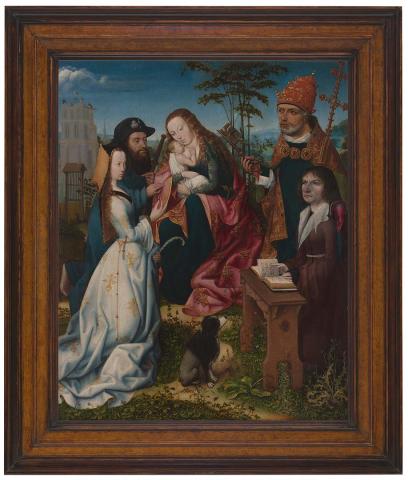LABEL: 1:1721 MASTER OF FRANKFURT
By Ineke Dane Geraldine Kirrihi Barlow
February 2024
This work is exemplary of late fifteenth-century Netherlandish panel painting in its religious subject matter, style and symbolic themes. The wealthy donor who commissioned the work is shown on the right, kneeling at the prayer desk as if participating in the holy scene with the Virgin and Child at its centre. The artist has superimposed the male donor’s head over that of a female figure, leaving her flowing robes and delicate hands intact. The religious symbols incorporated in the panel would have been understood by God-fearing audiences of the time: Saint Catherine holds the ring signifying her mystic marriage to Christ; Saint James wears a pilgrim’s hat and holds a staff; and, in papal robes, Saint Peter holds his common attribute, the key to Heaven. The dog is a symbol of faithfulness.
Usually part of larger, elaborate church altarpieces, panel paintings depicted scenes from the gospels and the life of Christ. Pigments — sourced from minerals, plants and other organic substances — were laboriously ground by hand, mixed with liquid media and painstakingly applied to timber panels.
This painting was made in the same year that Albrecht Dürer began ‘The Apocalypse’ series, demonstrating the close relationship between printmaking and painting styles during the Northern European Renaissance.
Connected objects
Metadata, copyright and sharing information
About this story
- Subject
